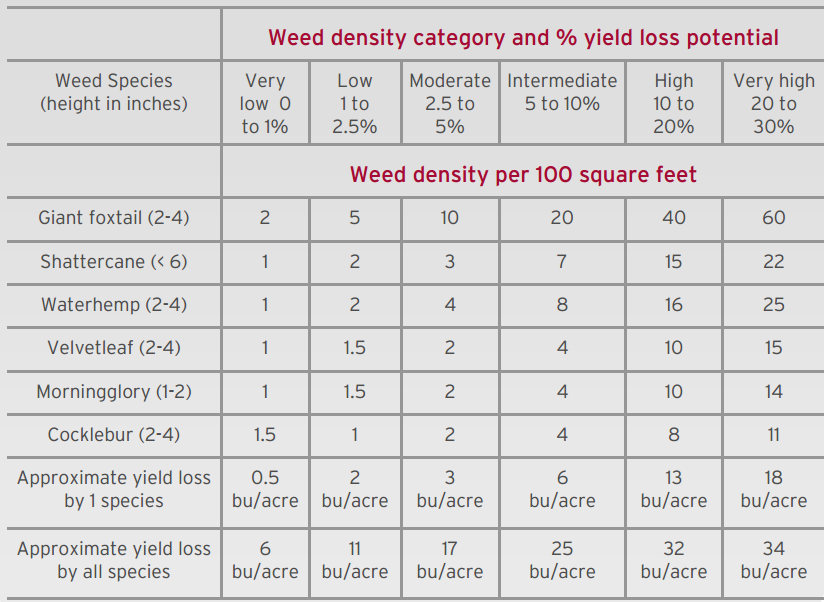Managing weed populations is about planning and repetition.
It’s hard to believe that we are approaching the threshold of planting 2018. Many soybean producers have spent the last 6 months learning new high-yield concepts and building their 2018 soybean production plan. Now is a great time to review the game plan and be prepared to make the appropriate changes based on the challenges of this season.
I can imagine that most Illinois soybean producers would agree that weed populations provide no value to a growing soybean crop and waterhemp needs to be aggressively managed.
This chart from the University of Missouri evaluates weed density and yield vulnerability. The data set does great job showing how different populations of a single weed species and the combination of additional species and their density can negatively impact soybean yields. This not only gives a value to keep weeds from growing in a soybean field, but also the value in selecting the appropriate herbicide to provide broad-spectrum control.

When implementing your 2018 herbicide program it’s important to take time to understand what weeds are present, their window of germination and what are effective options to manage them. Below are some topics or question to think about prior to implementing your 2018 herbicide program.
Management Tips:
- Winter annuals will emerge in the fall of the year and start to grow aggressively prior to planting. They can cause issues with tillage, seed-to-soil contact and, ultimately, stand establishment. Examples: marestail, henbit, chickweed and purple deadnettle.
- No-till fields should be scouted and considered for a pre-plant burndown application.
- A burndown will reduce weed pressure for weeds that can aggressively take over a field.
- Herbicides like 2,4-D or dicamba are sometimes left out of the spray tank and we rely too much on glyphosate. Glyphosate, applied in the spring, may not provide a complete kill.
- A partial kill of marestail will upset the plant and it will be very defensive and aggressive and almost impossible to kill later.
- 2. Spring annual broadleaf weeds emerge once the soils start to warm up.
- This population can cause issues from stand establishment, early season compaction from sunlight, moisture and nutrients.
- Small seeded broadleaf weed species produce small sized seeds that don’t have long term viability in the soil and tend to emerge close to the soil surface. Examples: waterhemp.
- Large seeded broadleaf weeds produce larger sized seeds that tend to have longer viability in the soil and tend to emerge slightly deeper. Examples: giant ragweed, velvetleaf, cocklebur.
General Weed Management:
- Know each field’s weed population history. This knowledge can help predict the predominant weed species and potential populations that may be experienced. This information, along with soil moisture and soil temperatures, can help to build and implement an effective herbicide program this spring.
- Not all residual herbicides are created equal; how effective are they against key weed populations?
- How effective will this herbicide residual be on small seeded broadleaf weeds?
- How effective will this herbicide residual be on large seeded broadleaf weeds?
- Does the residual herbicide provide any grass control?
- Based on the use rate, what is the duration of control when applied and activated?
- Heat, solar radiation and soil moisture to impact the ½ life of a selected residual herbicide.
- Based on the application data and emergence of the season, what quality of control should be expected – 50%, 80% or 100%?
- Other Consideration:
- What is the product’s active ingredient (A.I.)?
- What are the sites of action for each A.I.?
- What, if any, risk is associated with using the product?
As the title of this post states—“plant clean, grow clean, harvest clean and repeat.” Soybean herbicide management is a season-long or even a multi-season practice. It’s important to follow strong recommendations throughout the season. Sometimes the best person to get a herbicide recommendation from is the person not selling it to you.
So, take some time and seek out a knowledgeable Illinois CCA to help you understand and evaluate decision and performances. Abraham Lincoln once said, “Give me six hours to chop down a tree and I will spend the first four hours sharpening the axe.” Sharpen your blade and have a safe planting season.
For the past two years Steinacher has worked as a reginal agronomist for AgriGold®, covering west-central Illinois. Prior to working with AgriGold, he was with the GROWMARK/FS system for nearly 10 years working as a crop specialist, seed specialist and a field sales agronomist. Steinacher has an associate degree from Lincoln Land Community College, a B.S. in agronomy and business from Western Illinois University and a master’s degree from the University of Illinois, Champaign-Urbana.




 and then
and then